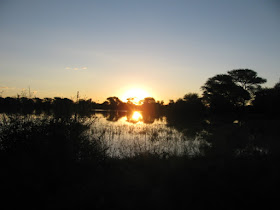Most Americans (including myself) no little about African history and the various independence movements. Namibia gained their independence from South Africa on March 21, 1990 after a very long struggle against European colonialism and domination by apartheid South Africa. A couple of weeks ago we visited the National Museum which addressed the region's history from the first Dutch explorers in the 1600's, the era of European colonialism, through the armed resistance that resulted in independence.
 |
| This is the National Museum. It has an interesting "Tea Pot" design and was built by the North Koreans. |
 |
| Sam Nujono - The George Washington of Namibia |
Anyway, in the late 1800's Germany annexed or colonized the region. Thus, the strong German influence that remains in the area as many of the streets in Windhoek still have German names and spellings. As with most of colonialism, it was all about control of the land and natural resources. As a result, the Germans forcibly removed or relocated many of the local tribes from their traditional homelands. Several tribes, mainly the Herero and Nama, revolted in armed resistance. The Germans won and slaughtered most of the tribes. It is estimated that 85,000 Herero fled into the desert ahead of the German army and only 15,000 survived. 10,000 Nama were also killed. Afterwards, the Germans issued an extermination order against the tribes. These events are memorialized near the Waterberg Plateau. As we speak, the Herero and Nama have sued the German government for reparations due to the genocide - they are seeking $30 billion NSD.
 |
| A memorial to the Herero and Nama resistance and deaths |
After WWI, the Germans conceded the region, then known as South West Africa, to the British. The British then in turn made the region a protectorate of South Africa (which the British Empire controlled at the time). After WWII, the UN passed a resolution that was intended to lead to eventual Namibian independence but South Africa refused to honor the agreement.
In the 1950's, the South West African People's Organization (SWAPO) was created and began a campaign of resistance to the South African government. SWAPO based their operations in southern Angola and would make cross-border raids into Namibia. Obviously, the South African government responded accordingly. Thus, began Namibia's long struggle for independence. Apartheid was also implemented during this same period.
Sam Nujono, the first president of Namibia, was one of the original SWAPO freedom fighters and lived in exile for three decades in Angola. He, as well as many of the SWAPO resistance fighters, are still alive today. Below is his statue. He is considered the equivalent of George Washington.
In the late 1960's, Portugal ceded Angola. Angola quickly fell into civil war between three regional/tribal factions. By the 1970's, the Angola civil war had narrowed to two main factions and became embroiled in Cold War era politics. One faction leaned communist/socialist and allied with the Soviet Union. That meant the U.S. had to side with the other faction which meant allying with South Africa despite the arms embargo imposed due to apartheid. SWAPO aligned themselves with the Soviet faction as their interest was opposing all things South African. Cuba eventually joined the conflict and at one point had 40,000 troops in Angola. That of course increased U.S. interest in the conflict. The museum had pictures of Fidel Castro meeting with Sam Nujono and other SWAPO leadership.
The conflict and battles occurred primarily in southern Angola and northern Namibia. As far as Namibia was concern, the conflict was essentially a stand still with neither side gaining any significant advantage. But, South Africa eventually recognized that there was no economically viable plan for continuing the prolong struggle and allowed the U.N. mandate for Namibian independence to proceed. The peace, including the end of the Angola civil war, was brokered by U.S. lead negotiations. Thus, Namibia held free elections and gained their independence.
SWAPO leadership won all of the elected positions and has remained the political party in power every since (receiving over 80% of the vote in the last election). The political leadership has respected established term limits and there have been multiple peaceful changes in leadership. But all of the leadership has come from former SWAPO freedom fighters, including the current president. It is equivalent to having the U.S. founder fathers still alive. So, Namibia is essentially a one-party democracy. Below are statues of some of the other founding fathers.
Locally, the United States is viewed as have been on the wrong side of history and government relations are on the cooler side. But, the locals show no hostility to Americans and we have been well received and treated. As you can see, Namibia history is complicated and is best represented by a nearby road intersection of Fidel Castro Blvd. and Bismark Strasse.
 |
| View of the Parliament Building |
 |
| View Looking Out Towards Windhoek from Parliament Building |
The National Museum has a nice restaurant on the top floor with some of the best views in Windhoek.
 |
| Krist Kurche from Top of the Museum |
 |
| Can actually see our apartment building behind the large white building |


















































